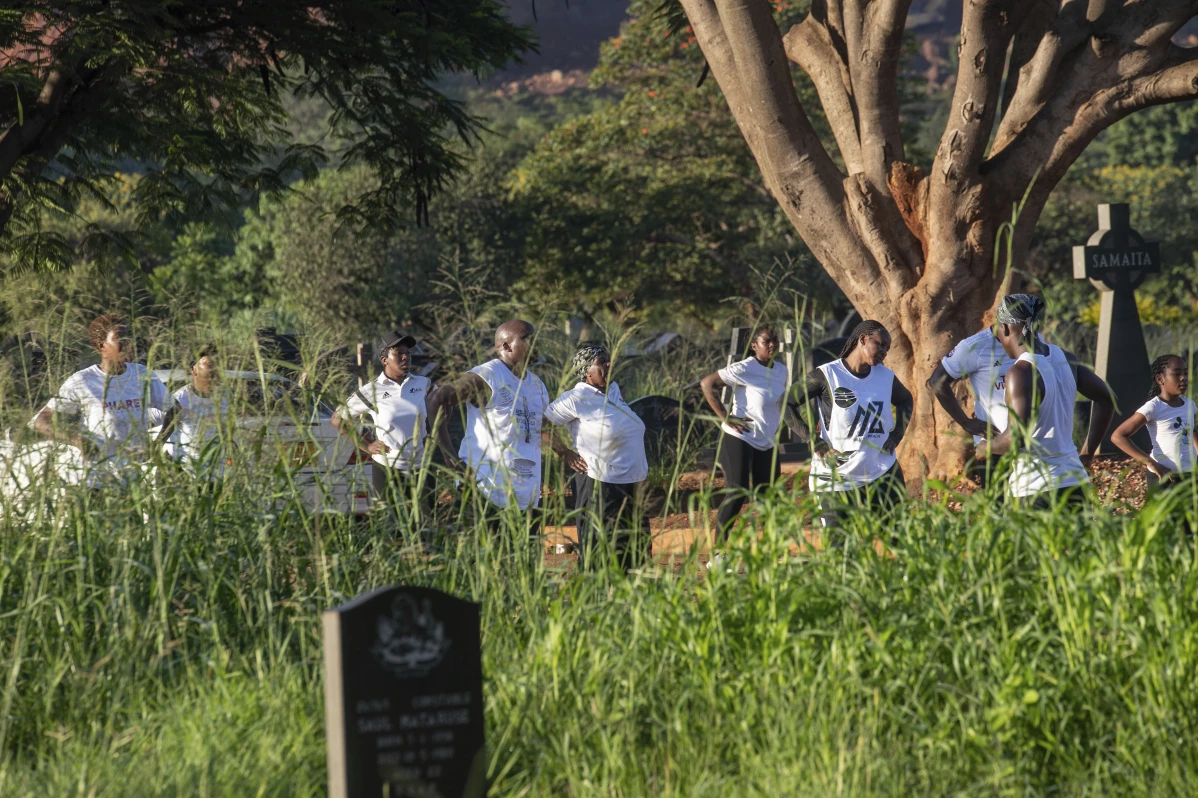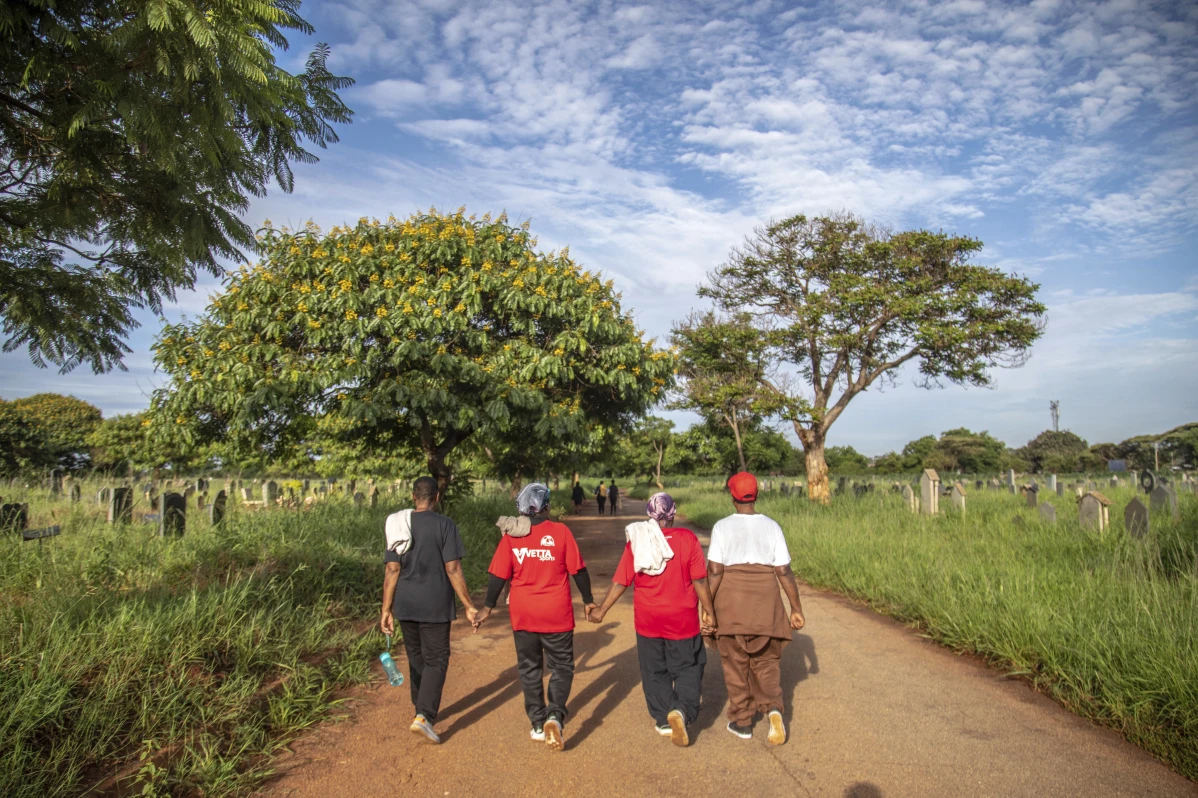John
Bradburne.
Image
via
The
John
Bradburne
Memorial
Society.
Maybe.
But
while
Zimbabwean
Bishop
Raymond
Mupandasekwa
of
Masvingo
believes
that
John
Bradburne
will
soon
be
officially
canonized
by
the
Catholic
Church,
the
bishop
is
sure
that
Bradburne
is
already
a
saint
in
the
eyes
of
God.
John
Bradburne.
Image
via
The
John
Bradburne
Memorial
Society.
“If
the
voice
of
the
people
is
the
voice
of
God,
then
John
Bradburne
is
already
a
saint”,
the
bishop
told
The
Pillar,
during
a
visit
to
the
international
Catholic
charity
Aid
to
the
Church
in
Need
(ACN),
in
Germany.
Bradburne
was
born
in
England,
the
son
of
an
Anglican
vicar.
As
a
young
man
he
felt
a
strong
spiritual
calling
and
eventually
converted
to
Catholicism.
He
flirted
with
the
idea
of
becoming
a
priest,
before
deciding
that
wasn’t
his
vocation.
His
spiritual
searches
and
travels
eventually
landed
him
in
what
is
now
Zimbabwe,
where
he
lived
with
the
Jesuits
for
a
while,
before
a
chance
visit
to
the
leper
colony
of
Mutemwa,
in
the
company
of
a
friend,
Heather
Benoy.
What
he
saw
there
would
determine
the
course
of
the
rest
of
his
life.
“The
lepers
were
covered
in
filth
and
untreated
running
sores”,
writes
Didier
Rance
in
his
biography
“John
Bradburne:
Vagabond
of
God.”
“Worse
was
to
come.
Surprised
by
the
arrival
of
strangers,
the
lepers
retreated
to
their
huts
and
re-emerged
with
a
sack
or
a
blanket
covering
their
heads.
John
and
Heather
witnessed
a
leper
with
a
sack
crawling
through
mud
along
the
ground
on
all
fours.
Stupefied,
John
demanded
to
know
what
was
going
on,
to
discover
that
the
lepers
were
forced
to
cover
their
faces,
because
they
were
too
ugly
to
be
seen.”.
That
day,
Bradburne
decided
that
he
was
where
God
wanted
him.
He
dedicated
the
rest
of
his
life
to
serving
lepers,
vastly
improving
their
living
conditions
but,
above
all,
showing
them
that
they
were
loved,
and
upholding
their
dignity.
His
dedication,
even
when
the
region
became
dangerous
due
to
insurgent
activity,
made
him
very
popular
among
the
local
population.
However,
a
few
years
ago
rumors
spread
that
his
beatification
process
might
be
stalled
because
it
could
be
politically
controversial
if
the
first
saint
of
Zimbabwe,
a
country
where
race
relations
are
still
a
sensitive
subject,
should
be
a
white
man.
In
the
violent
and
often
tragic
history
of
Zimbabwe
in
the
decades
following
independence,
race
has
often
played
a
central
role
—
both
in
cultural
conflict
and
in
government
policy.
But
even
in
his
own
lifetime,
Bradburne’s
example
of
love
and
service
seemed
able
to
transcend
racial
divisions.
Kate
Mcpherson,
from
the
John
Bradburne
Memorial
Society,
told
The
Pillar
that
“although
there
was
such
muttering
early
on,
this
is
history
now
–
evidenced
by
the
Zimbabwean
bishops
supporting
John’s
cause
and
the
country
recently
declaring
him
a
national
hero.”
Bishop
Mupandasekwa
concurred,
saying
“he
is
the
most
popular
saint
in
the
eyes
of
the
people,
even
before
canonization.
The
most
popular!
His
shrine
is
visited
by
at
least
100
thousand
people
a
year,
and
they
come
from
January
to
December”,
he
explained,
adding
that
the
idea
of
his
race
presenting
difficulties
is
“not
true
at
all.”
“People
love
him,
we
have
many
witnesses
from
as
far
back
as
the
1970s,
including
old
lepers
who
were
looked
after
by
John,
and
when
they
talk
about
him
it
is
like
they
are
still
seeing
him.
They
don’t
see
him
merely
as
a
white
man
at
all,
they
see
him
as
a
saint,
and
as
one
of
their
own.
People
would
love
to
have
him
declared
a
saint,
because
that
is
what
he
was.”
What
may
be
an
obstacle
to
the
advancement
of
the
beatification
process,
which
is
still
in
the
diocesan
phase,
is
the
infrastructure
of
the
shrine
itself,
the
bishop
said.
“The
only
thing
that
perhaps
is
stopping
growth
in
devotion
to
John
Bradburne
is
the
state
of
the
shrine.
There
is
no
place
for
people
to
stay
when
they
visit,
unlike
other
shrines
where
you
would
find
lodgings,
where
people
can
sleep
and
then
spend
the
day.
This
is
a
huge
challenge.
The
infrastructure
does
not
allow
for
big
crowds,
it
can’t
handle
them.
If
only
we
could
develop
that,
we
could
see
more
people
come.”
Mcpherson,
who
is
Bradburne’s
great-niece,
said
that
these
plans
are
already
underway.
“There
are
lots
of
plans
to
improve
Mutemwa,
but
this
is
all
dependent
on
money.
There
are
plans
to
build
a
new
church
to
house
all
the
visiting
pilgrims
so
they
can
say
Mass,
along
with
new
toilets
and
accommodation.
Future
plans
are
definitely
to
create
a
better
infrastructure,”
she
told
The
Pillar.
Eagles,
bees
and
the
dancing
sun
Despite
the
fact
that
Bradburne
has
not
yet
been
beatified,
let
alone
canonized,
many
people
attribute
miracles
to
his
intercession,
and
Bishop
Mupandasekwa
himself
said
he
witnessed
a
miraculous
event
there
in
1994.
“The
devotion
to
John
Bradburne
is
huge.
I
am
also
one
of
those
who
has
a
devotion
to
him.
I
am
a
witness
of
the
miracle
of
the
dancing
sun.
I
led
a
pilgrimage
to
Mutemwa
one
day
and
went
up
the
Chigona
mountain,
where
he
used
to
pray.
It
was
about
3
p.m.,
and
after
praying
our
rosary
we
looked
up
and
we
could
see
the
sun
dancing.
I
was
squinting,
wondering
if
this
was
really
true,
and
it
danced
for
five
minutes.
We
were
amazed!”
Mcpherson
told
The
Pillar
that
she
too
is
sure
the
miracle
took
place,
and
that
the
society
is
in
possession
of
a
video
of
it.
Besides
his
love
for
the
lepers
he
served,
Bradburne
was
an
avid
poet
and
enjoyed
dancing,
although
a
friend
of
his
brother’s,
who
danced
with
him
at
a
party,
later
said
“he
can
dance,
but
it
was
like
dancing
with
Jesus
Christ.”
John
also
nurtured
a
great
love
for
animals,
and
many
of
the
purported
miracles
associated
with
him,
both
during
his
life
and
after,
are
related
to
them,
from
bees
to
eagles.
While
he
lived
with
the
Jesuits,
he
would
sometimes
become
exasperated
by
the
number
of
visitors
who
would
come
calling,
disturbing
his
writing.
On
one
occasion
he
is
said
to
have
prayed
for
respite,
and
soon
enough
a
swarm
of
bees
installed
itself
in
his
room,
buzzing
around
him
while
he
wrote,
and
keeping
unwelcome
guests
away.
In
Mutemwa,
Bishop
Mupandasekwa
said,
“there
is
a
little
hut
where
he
used
to
sing
in
praise
of
God
all
night,
and
sit
in
prayer.
And
the
bees
sometimes
come
and
cover
the
whole
of
the
hut,
and
after
a
bit
they
fly
away.
It
is
very
much
associated
with
the
presence
of
John
in
the
place.
He
has
not
left.”
In
1982
Angus
Shaw,
a
sceptic
who
was
annoyed
by
stories
of
miraculous
bees,
visited
Mutemwa
to
try
and
dispel
the
myths.
When
he
returned
to
his
car
it
had
been
invaded
by
bees,
and
when
he
finally
made
it
back
to
Harare
his
apartment
was
overrun
by
the
insects
as
well.
Another
episode
involving
animals
raises
deeper
theological
questions.
John
kept
a
pet
eagle,
Haggai.
She
was
attached
to
a
perch
by
a
long
rope,
but
one
day
when
a
male
flew
by,
Haggai
pulled
so
hard
that
she
broke
loose,
trailing
the
rope
behind
her.
A
distraught
Bradburne
found
Haggai
a
few
days
later.
The
rope
had
become
entangled
in
the
branches
of
a
tree,
and
she
had
died.
On
the
first
anniversary
of
Haggai’s
death,
“John
laid
flowers
on
her
grave,
and
prayed
to
the
Blessed
Virgin
to
give
him
a
sign
that
his
eagle
was
now
free
and
happy
in
paradise.
Shortly
afterwards
an
enormous
eagle,
almost
completely
white,
appeared
in
the
sky,”
Rance
wrote.
“The
eagle
hovered
over
the
pine
copse
where
Haggai
was
buried,
and
then
flew
off
in
the
direction
of
the
valley.
John
never
again
saw
such
a
bird,
but
for
him
the
sign
was
obvious.”
His
passion
for
animals
was
one
of
the
reasons
he
identified
with
St
Francis
of
Assisi.
When
he
became
a
tertiary
Franciscan,
he
took
to
wearing
the
brown
religious
habit
for
the
rest
of
his
life.
‘He
wrestled
with
the
evil
one,
and
triumphed’
In
September
1979
a
pair
of
young
mujibhas
–
the
name
given
to
groups
who
aided
the
guerillas,
but
ranked
beneath
them
–
kidnapped
John
from
Mutemwa
and
marched
him
to
their
hideout.
They
mocked
and
humiliated
him,
though
witnesses
say
that
he
was
serene
the
whole
time,
despite
knowing
that
he
was
likely
not
going
to
escape
alive.
The
next
day,
they
took
him
to
the
guerrillas,
hoping
to
receive
praise
for
capturing
a
white
man,
but
were
instead
reprimanded
because
John
was
known
to
be
a
friend
of
the
Africans.
The
mujibhas
were
humiliated
and
promised
to
return
him
to
Mutemwa,
but
instead
took
him
to
another
rebel
group
who
agreed
to
put
him
on
trial.
Even
so,
he
was
declared
not
guilty
of
any
crime.
However,
he
had
seen
the
groups’
hideouts,
and
they
feared
that
the
Rhodesian
security
forces
would
make
him
talk.
They
offered
to
transfer
him
to
Mozambique,
but
he
said
he
would
not
go
anywhere
except
back
to
the
leper
colony,
where
he
was
needed.
The
rebels
released
him
from
his
bonds,
ate
and
drank
with
him,
then
shot
him
dead.
At
that
time
his
good
friend
Fr.
John
Dove,
who
was
in
prayer
and
unaware
of
what
had
happened
to
Bradburne,
said
he
“experienced
a
moment
of
agony
which
he
felt
was
neither
his
own
nor
Christ’s.”
Worried
about
reprisals
if
the
security
forces
found
his
body
there,
local
villagers
tried
to
hide
it,
but
were
driven
away
every
time
they
came
near,
either
by
the
sound
of
chanting,
unexplained
rays
of
lights
or,
at
one
time,
by
the
presence
of
a
large
white
bird
hovering
over
the
body,
rising
and
descending
as
if
to
protect
it.
Bishop
Mupandasekwa
was
nine
years
old
when
John
was
killed,
and
never
met
him.
But
the
bishop
did
know
Fr.
Dove,
“the
Jesuit
who
invited
him
to
Africa
and
to
Zimbabwe,
who
was
really
his
mentor,
so
for
years
I
have
heard
a
good
number
of
stories
from
people
who
knew
John
and
who
were
witnesses
to
his
life
in
Mutemwa,
and
I
am
convinced
that
he
is
a
saint.”
“I
have
preached
in
many
Masses
celebrating
his
life
in
Mutema,
and
it
has
been
refreshing
to
be
there,
to
see
the
great
devotion
to
John
Bradburne,
and
the
high
regard
for
him,
and
the
desire
for
him
to
become
canonized.
It
is
a
big
thing
in
Zimbabwe
today,”
he
concluded.
His
biography
quotes
one
pilgrim
answering
the
question
of
why
so
many
people
visit
the
site:
“They
come
because
they
sense
this
place
is
holy.
They
sense
that
in
this
place
someone
wrestled
with
the
evil
one
and
triumphed;
that
this
person
became
more
human
as
a
result
and
so
approached
the
divine
more
closely.
And
they
feel
that
this
was
not
for
himself
alone,
but
for
all
of
us.”
John
Bradburne
was
declared
a
Servant
of
God
by
the
Church
in
2019,
and
his
beatification
process
continues.
The
postulator
of
his
cause,
Italian
canon
lawyer
Enrico
Salinas,
did
not
respond
to
a
request
for
comment,
but
in
his
latest
update
published
on
the
website
of
the
memorial
society,
in
November
2024,
he
wrote:
“Personally,
I
hope
that
2025
will
be
a
‘special’
year
for
John’s
cause
and
that
the
jubilee
announced
by
Pope
Francis
will
coincide
with
the
possible
end
of
the
diocesan
information
process.”
Source:
Could
an
Englishman
be
Zimbabwe’s
first
saint?
Post
published
in:
Featured






 Olga
Olga
 Kathryn
Kathryn









